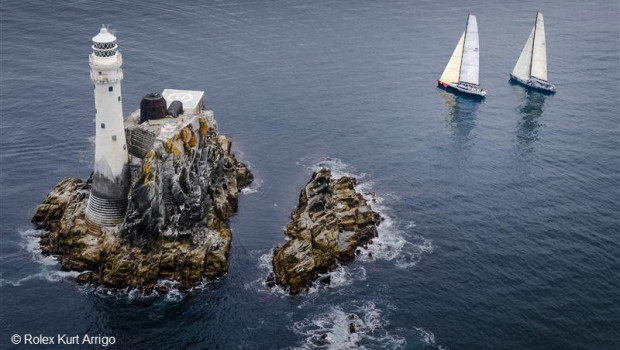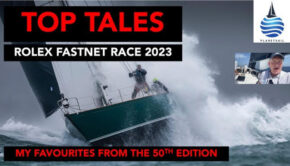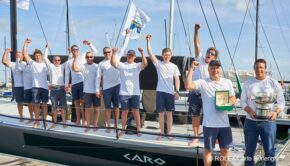Fastnet Race: Starting with a High, Racing with a Prayer
Published on August 14th, 2015
by Mark Chisnell, B&G
The Rolex Fastnet Race 2015 will start for the first class – the multihulls – at midday on Sunday 16th August. The course is unchanging; 603 miles along the south coast of England to Lizard Point, and then turning north-west into the Irish Sea and heading for the Fastnet Rock off the southern tip of Ireland. Once around, it’s south-east back to the Isles of Scilly, before turning back east to the finish in Plymouth.
There are almost 400 boats entered, racing on handicap under IRC – it’s a diverse fleet spread from Jim and Kristy Hinze Clark’s brand new 100’ Comanche, to the Contessa 32s. I’m not about to predict a winner – the race and the conditions are far too uncertain to try that – but we can look at some of the tactical and strategic hurdles that will make the difference between winning and losing.
We are going to have to do this in very general terms – unlike the one-design Volvo Ocean Race fleet that started together and sailed at the same speed, the options for this fleet will vary widely with staggered starts and massive differences in pace. Any analysis of the specifics of the tactical, strategic and meteorological battle is difficult when the fleet will be spread all along the course at different times. But I think we can pull out a few essential truths… let’s start with a quick weather over-view.
The action will start with a serious absence of wind.
There, I’ve said it. Take a quick look at Pic 1 from the marvelous Magic Seaweed. There is a big area of high pressure centred over the British Isles, with very little wind along the south coast or out into the English Channel.
Things haven’t changed much in Pic 2, with high pressure still dominating on Monday lunchtime.
But on Tuesday a couple of low pressure systems move into the picture, in Pic 3; one from the east, and one from the west, and they will seriously shake things up. It will almost certainly mean that we have a small boat winner of the handicap prize. The bigger boats will sail all their race in light winds, while it looks like the smaller boats will do at least half of it in some solid breeze.
However, this situation is very dynamic and I’m not going to put a whole lot of weight on the forecast for the middle of the week. This time yesterday the high pressure was forecast to dominate all the way through to Friday, so all we can expect is the unexpected. Either way, I would certainly pack an extra couple of Mars bars (other snacks are available).
Given the rather flaky forecast, we should probably focus most of our attention on the first part of the race, down to the Lizard. The tide is always important in this section, just because it runs so strongly across most of the race course – up to 5-6 knots at times on the major headlands that have to be passed. It will be doubly, triply so this time around because of the lack of wind to power against it.
For the first six hours in every twelve (roughly) the tide will be taking the race teams towards their goal, and they will be trying to get out into the deep water of the main channels and make the most of it. And for the next six hours it will be trying to suck them inexorably backwards. Those that cannot find shelter in weaker tide in the shallow water of the coast may well find themselves hauling out the anchor. Let’s hope they have enough rope onboard to find the bottom with it.
The importance of the tidal stream will start right from when the gun goes. The first fleet are the multihulls and they will get away about an hour and a half before high water, so the ebb will only just be starting on the very edges of the race course – these boats are big and powerful, but lack the manoeuvrability to get inshore and tack up the beach – they will be relying on their power to make some progress in the light winds.
The smaller IRC classes – 3 and 4 start at the optimal point in the tide, and will have the most time with a favourable current under them to get west. The final starts are for IRC 1, and for IRC Z, IRC Canting Keel and Volvo 65s – respectively at 13:20 and 13:40, right around high water. They will have less time with the ebb, but they won’t need it as much as they will get west much quicker. The initial race is to get around Portland Bill before the tide changes – but I’m getting ahead of myself, let’s get out of the Solent first.
Everyone will be looking to optimise their path on the traditional route out of the Solent in an ebb tide. This section is usually done in a sea breeze, and in that case there is a very particular route that keeps you in the best tide – the current forecast is for a light south-westerly on Sunday; sea breeze direction but not sea breeze strength!
Whatever wind the fleet do have, they can at least be secure in the knowledge that if they get themselves in the best tide they will be exiting the Solent at about 3-4 knots over the ground. Fortunately, the published tide tables are remarkably accurate these days, and a lack of local knowledge is no excuse when a tenner at the chandlery can get you some of the best info available.
So much for the Solent, once the fleet get to the Needles Fairway buoy they will almost certainly be faced with the most important strategic decision of the race. Do they go offshore or inshore? The ‘normal’ route in a south-westerly is to stay inshore, tacking up the coast.
The advantages of the inshore route are that all the headlands provide an extra tidal push, and often a wind shift that can be utilised: if you tack inshore to pass Old Harry near Poole, there can be a big right-hand shift as you exit the headland on starboard, and this gets you efficiently into the good tide out of Poole and the tidal ‘rip’ around Anvil Head. At both Anvil Head and St Albans staying on starboard tack as you go past keeps you in the rip and can provide big gains.
Like the route out of the Solent, this is a well-worn race track, the moves all thoroughly understood by the regulars. The goal is to get past Portland Bill before the tide changes, and in a light air race the boats that make it will then have another six hours to tuck up into the bay towards Lyme Regis, and make good progress against the weaker tide. Those trapped the other side of Portland Bill may well make no progress at all for those six hours, finding it impossible to sail against the five knots of tide or more that pour around the Bill in a vicious rip.
However, this year the forecast south-westerly is much weaker than a regular 15-20 knot sea breeze, and so the decision will be very different. The tidal gains from the headlands will still be available, but that won’t help you if there isn’t enough wind to get past Portland Bill before the tide changes. You will spend the first half of the first night at sea getting tossed around in the rip, or bouncing off the rocks in a big park up as everyone tries to anchor as close to the Bill as possible, hoping to get a headstart when the tide does change.
The other option is to go offshore. The risk here is that there is nowhere to run and nowhere to hide once the tide turns against you. The water may well be too deep to anchor, and instead of an uncomfortable six hours being bounced around on the kedge at the Bill, you spend six hours going backwards on the flood tide.
Unless.
Unless there is more wind offshore. In which case, there might be enough to hold your own, or even go forward against the flood tide. This is exactly the type of problem that we can apply the Deckman to – let’s have a look at Pic 4 which shows the Deckman’s calculated optimal route from the Needles west along the coast. The red line heading south and then west from the green boat at the Needles is the way the Deckman thinks you should tackle this year’s Fastnet.
We calculated this route based on the performance of a generic modern 40 footer, and it’s sending a boat like that out into the middle of the English Channel to find the wind. We can also look at Pic 5, which is the same calculation but for the performance of a generic modern 70 footer. The two routes are remarkably similar – go south, people. Starboard tack away from the Needles looks to be the winner.
The forecast has the wind slowly rotating to the north-west (it will get there by about 22:00) – and this will create the long, slowly lifting starboard tack, the curved red line that you see slowly coming onto course, and going due west to Lizard Point, before the step out into the Irish Sea. The wind will eventually go to the north-east, and what started a beat will finish as a run.
This sounds a pretty good option to me, it’s certainly a lot simpler and less stressful than the battle around all the headlands inshore! However, we can dig into this a little more (if we’re nerd-ishly inclined) and take a look at Pic 6. This is identical to Pic 4, except that we have left the isochrones (vertical black lines) and the other possible routes (horizontal black lines) in the image.
An isochrone is a line showing all the places that the boat could reach in the same amount of time. The thing to notice is that the wave of the black spider web of isochrones is moving west at a relatively even rate. There is an advantage to being offshore, but it’s not that great.
This is even clearer in Pic 7, which is a zoomed in view of Pic 5 with a single isochrone in place at Portland Bill. It’s almost a straight line north-to-south, which means that there is nothing in it; inshore or offshore could pay, and it will come down to execution of the plan, and the randomness of the shifts and puffs at the micro level. Or, of course, the weather could turn out completely different to the forecast used for this calculation…
But assuming that the forecast doesn’t change, and this result is still the case on Sunday afternoon when the fleet clear the Solent, then the smart navigator and tactician have a few choices:
a) Stick with the competition
b) Redo the calculation with a couple of other sources of weather data and see if there is 2-1 winner
c) Flip a coin
Personally, I’d go with b) and if that didn’t change anything I’d go with a) – although c) has its merits, particularly if you’ve had a big night on Saturday. Whatever the contenders choose to do it’s going to be a very interesting opening 48 hours.
After that, through Tuesday and Wednesday things simplify a great deal. We can see in Pic 8 that the low approaches from the west, and sets up a strong southerly over the Irish Sea and then moves into south-west England. It will make the section out to the Fastnet, back to the Scilly Isles and then onto Plymouth a series of straight-line fetches and reaches, and the closing stages of the race will be largely about boat speed.
The one big tactical implication is that the wind will fill from the west, so given a choice the smart navigator will stay that side of the opposition once they get past Lizard Point and turn north-west towards the infamous Rock
And that’s about it, it’s looking like a good race – have fun out there if you’re going, I’ll be back once the handicap prize has been settled to review how it turned out.
Background: The 603nm Rolex Fastnet Race is organised by the Royal Ocean Racing Club (RORC), with the 46th edition of the biennial race to start off the Royal Yacht Squadron line, Cowes, Isle of Wight on Sunday 16th August 2015. It is the largest offshore race in the world and attracts the most diverse fleet of yachts.


















 We’ll keep your information safe.
We’ll keep your information safe.